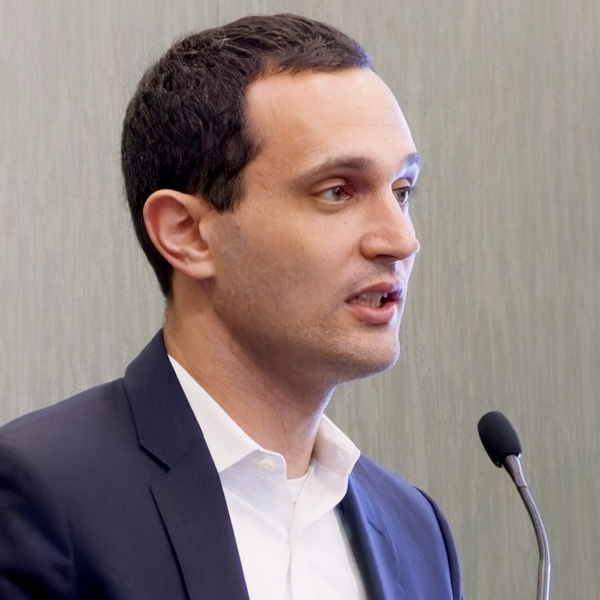Average load-weighted electricity prices in PJM fell by about half in 2023, the Independent Market Monitor said in its annual State of the Market Report, finding the lower prices came largely from a drop in natural gas prices that reversed a record-high spike last year.
The decrease brought real-time load-weighted LMPs to an average of $31.08/MWh in 2023, down from $80.14 the previous year. In a briefing ahead of the March 14 report, Monitor Joe Bowring said the correlation between declining electricity and natural gas prices demonstrates PJM’s markets are working to translate lower fuel costs into savings for consumers. (See PJM Monitor: Rise in Fuel Costs Led to Record-high Prices in 2022.)
Bowring said it’s unclear how the March 12 ruling from the 3rd U.S. Circuit Court of Appeals partially vacating FERC’s order permitting PJM to revise the reliability requirement for the DPL South zone will be implemented and how it may affect prices. (See 3rd Circuit Rejects PJM’s Post-auction Change as Retroactive Ratemaking.)
The Monitor’s report found PJM’s energy and capacity markets were competitive in 2023, though local and aggregate markets within both had the potential for market power to be exercised, and the capacity market design’s effectiveness was mixed. The regulation and financial transmission rights markets both were found to have flawed market designs limiting competitiveness, and while the reserve markets performed well, some subzones saw high supply concentration.
In the local energy market, transmission constraints created opportunities for market power, and the Monitor said not all resources that fail the three-pivotal-supplier (TPS) test are being properly mitigated to their cost-based offers.
“The goal of competition in PJM is to provide customers reliable wholesale power at the lowest possible price, but no lower. The PJM markets have done that. The PJM markets work, even if not perfectly,” the Monitor wrote.
The Monitor identified future economically and policy driven generation retirements as a leading challenge PJM will have to face, with up to 58 GW of generation at risk of deactivation through 2030. But Bowring said the actual number may be lower if a drop in the number of resources available to offer capacity leads to higher prices. If clearing prices double in coming auctions and a portion of the economic retirements are delayed, he said the number of resources going offline could be about 43 GW. PJM’s February 2023 “4R’s” report found about 40 GW of generation is at risk. (See “PJM White Paper Expounds Reliability Concerns,” PJM Board Initiates Fast-track Process to Address Reliability.)
“PJM stands by the estimates in our 2023 report, ‘Resource Retirements, Replacements and Risks,’ which documents that 40,000 MW of generation are at risk of retirement by the end of this decade. The IMM’s higher at-risk retirement numbers are the result of more conservative assumptions,” spokesperson Jeff Shields said.
“Our greatest concern remains the pace at which new generation projects are getting built once the PJM process is complete. Currently there are approximately 40,000 MW in new generation projects that have been cleared for interconnection by PJM but are not being built; a number of a factors outside of PJM’s influence, including siting, financing and supply-chain, continue to hold up the completion of projects.”
Bowring said several changes to PJM’s rules around resource deactivations could correct market signals and limit costly reliability-must-run (RMR) contracts. Because transmission needs aren’t a factor in the reliability metrics used to determine Base Residual Auction procurement needs, he said it’s possible for a generator to not clear the auction and file for deactivation only to be told it’s needed to prevent transmission issues.
The cost of retaining a generator on an RMR contract can be steep; Bowring said the cost-of-service recovery rate for Indian River Unit 4 has been about 10 times the capacity revenues the 410-MW coal unit would have received since its RMR contract began in June 2022.
PJM’s practice of counting resources operating under an RMR contract toward reliability procurement targets in the capacity auction also could be suppressing market signals incentivizing generation needed for long-term resource adequacy.
Shields said PJM’s notification requirements for deactivating resources and its compensation structure for RMR contracts is under discussion at the Deactivation Enhancements Senior Task Force.
“We hope that the IMM will continue to work with us and capacity market participants to ensure that all market-seller costs, including risk, are includable in market offers so that economically viable resources can recover their costs and therefore remain in service,” he said.
Bowring argued that an ongoing stakeholder process to facilitate transferring capacity interconnection rights from a deactivating resource to replacement generation under the same ownership should be rejected and PJM instead should use any transmission headroom freed up by resources going offline to advance the interconnection of any planned resources that could resolve transmission violations that may be caused by the deactivation.
The report urged PJM to analyze the amount of firm gas capability in its region while expecting much of the needed new capacity will come from gas-fired generation. While it notes there is more than 200 GW of intermittent generation in the interconnection queue, the report argues that based on historical completion rates and capacity derates, that will amount to about 11 GW.
“PJM and federal and state regulators cannot hope to balance supply and demand without first having a clear and reasonably accurate measure of both existing and expected supply and demand. Providing clear information to regulators and market participants about the actual and expected supply-demand balance is essential so that decisions about market design, about the timing of environmental regulations, about pipeline siting and about transmission siting can all recognize the likely impact on the balance between supply and demand and therefore reliability,” the report says.



